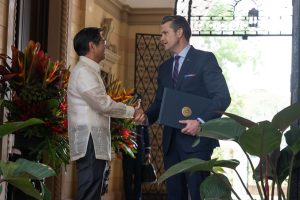China’s military says that it conducted a patrol in the South China Sea on Friday, the same day that U.S. Defense Secretary Pete Hegseth arrived in Manila and reaffirmed Washington’s “ironclad” commitment to its alliance with the Philippines.
On Saturday, a spokesperson for the Southern Theater Command of the People’s Liberation Army (PLA) said that it had conducted a “routine patrol” in the disputed waterway, according to a Chinese state media report. It did not reveal the exact location.
The spokesperson also said that the Philippines had “frequently sought to rally external countries to conduct so-called joint patrols, promoting illegal claims in the South China Sea, creating instability in the region and deliberately undermining regional peace and stability.” The Southern Theatre Command “remains on high alert, resolutely defending national sovereignty, security, and peace and stability in the South China Sea,” he added.
The PLA patrol was no doubt intended to coincide with Hegseth’s visit to the Philippines, part of a regional tour that will also take him to Hawaii, Guam, and Japan. In Manila on Friday, Hegseth met President Ferdinand Marcos Jr. and Defense Secretary Gilberto Teodoro, during which the two sides discussed ways to bolster deterrence in the face of China’s growing power and adventurism in the South China Sea.
For the past few years, China has increased both the intensity and frequency of its incursions into the Philippines’ exclusive economic zone. This has resulted in a series of dangerous confrontations between the China Coast Guard and various Philippine vessels, in which Chinese ships have rammed their adversaries or doused them with high-pressure water cannons.
During a joint press conference with Teodoro, Hegseth said that the Biden administration’s weakness had emboldened China and that President Donald Trump was aiming to reestablish the U.S. Army’s “warrior ethos.”
“What we’re dealing with right now is many years of deferred maintenance, of weakness, that we need to reestablish strength and deterrence in multiple places around the globe,” Hegseth said, according to the Associated Press.
“Deterrence is necessary around the world, but specifically in this region, in your country, considering the threats from the communist Chinese,” Hegseth added.
Hegseth also announced that the U.S. would deploy “more advanced” defense equipment in the Philippines, including the Navy-Marine Expeditionary Ship Interdiction System (NMESIS), and “highly capable unmanned surface vessels,” the U.S. Department of Defense said in a statement.
It added that NMESIS, a highly mobile coastal anti-ship missile system, would be used during this year’s Balikatan military exercise, which is due to begin on April 21. Ten thousand U.S. troops will participate in the drills, alongside 6,000 service members from the Philippines, Australia and Japan.
Hegseth added that the two nations had also agreed to conduct “advanced” bilateral special forces training operations on Batanes, the Philippines’ northernmost island, which lies roughly half-way between Luzon island and Taiwan.
The Defense Department statement also included what has now become a ritual reaffirmation that the U.S.-Philippines Mutual Defense Treaty “extends to armed attacks against either country’s armed forces, aircraft, and public vessels – including those of their coast guards – anywhere in the South China Sea” – an assurance first granted by the first Trump administration in 2019.
In response, a spokesperson for China’s Ministry of Foreign Affairs urged Washington “to abandon the Cold War mentality, stop provoking ideological confrontation and stirring up trouble in the South China Sea, cease sowing discord, and stop being a troublemaker in the region.”
Hegsth’s meetings with Marcos and Teodor took place the same day that the U.S., Japan, and the Philippines held maritime drills in the South China Sea. The drills, officially known as the Multilateral Maritime Cooperative Activity, took place in the waters off the coast of Scarborough Shoal.
The drills brought together the Philippine Navy’s BRP Jose Rizal, a U.S. Navy guided missile destroyer, the DDG Shoup, and a Japanese multi-mission frigate, the JS Noshiro. The three vessels “sailed in formation and communicated by radio,” and a small group of U.S. sailors from the DDG Shoup “used a speedboat to transfer to the BRP Jose Rizal and hold discussions with Filipino counterparts,” the AP reported.
According to the news agency, which was among the small press corps permitted to cover the drills, the drills were monitored by a Chinese military ship that “kept watch from a distance.” It is unclear if this ship was the patrol announced by the PLA on Saturday.
Hegseth’s comments offer another strong indication that the Philippines has avoided the worst of the disruptions ushered in by the Trump administration, and will remain a priority partner for the U.S. – in large part because it sits on the frontlines of China’s expanding maritime power in a crucial part of the world.
Whether the U.S. can achieve “peace through strength” in the South China Sea remains to be seen. Based on past precedent – and the Biden administration was hardly shy about strengthening security cooperation with the Philippines – it is more likely that China will continue to push back against what it sees as Manila’s internationalization of the South China Sea dispute.

































